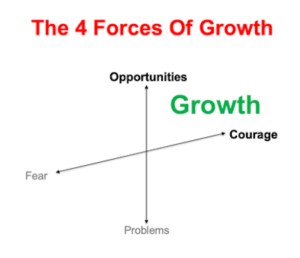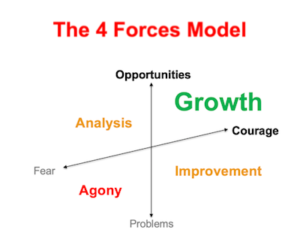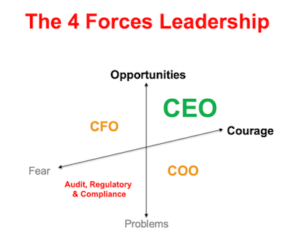#137 The Four Forces of Growth: What CEO’s need to focus on to sustain growth
Release Date: 11/21/2022
 #166 Necessary endings
#166 Necessary endings
The Growth Whisperers podcast
"Necessary Endings" is a self-help book written by Dr. Henry Cloud. It explores the concept of embracing and initiating endings in various aspects of life, such as relationships, careers, and personal growth, in order to create a positive and fulfilling future. The book emphasises that endings are a natural part of life and are necessary for personal and professional growth. While endings are a natural part of business and life, we often experience them with a sense of hesitation, sadness, resignation, or regret. But Dr. Henry Cloud sees endings differently. He argues that our personal...
info_outline #165 The top five reasons people regret selling their business
#165 The top five reasons people regret selling their business
The Growth Whisperers podcast
There is an entire industry and philosophy surrounding why you should sell your business, but it doesn’t need to be that way. There are many reasons why people choose to sell their businesses and really the reasons can be broken down into two different things. 1. Long Term Goal To Exit: A strategic decision because their plan all along was to sell their business and they have something else more desirable to do with their time (besides golf). 2. Looking for an Exit strategy after losing faith. They hit a point of frustration or desperation and are no longer either enjoying...
info_outline #164 Using the sandbox to stop dumb decisions in the leadership team
#164 Using the sandbox to stop dumb decisions in the leadership team
The Growth Whisperers podcast
Without effective discipline around decision making we can end up making decisions we later might call dumb. To avoid this one of the tools we use is the sandbox. Where we play. Our sandbox is where we have proven that we can win and earn the right to be a viable option for our customers. And the principle helps us to keep sand in the box. What we sell, Who we sell it to and where we sell it. Like any principle creates focus and guardrails for our thinking and decisions. When going outside of these guardrails, we need to do it with extreme caution and this takes a lot of humility at times -...
info_outline #163 Executive burnout: Building your resilience (2/2)
#163 Executive burnout: Building your resilience (2/2)
The Growth Whisperers podcast
Executives are often more driven than the average person. We run hard all the time, and it usually works. And then, it doesn't work. We persist and push harder than the average person, and that's why we win. But it's also why we can crash harder and sometimes even put everything at risk. This week we talk about executive burnout in the second of two episodes. What it means, what to look out for in both yourself and your team, and when it might be time to go get some help. ----- * Do you love The Growth Whisperers and want to see our smiling faces? Subscribe to our ....
info_outline #162 Executive Burnout: How do you know when you need to get some help? (1/2)
#162 Executive Burnout: How do you know when you need to get some help? (1/2)
The Growth Whisperers podcast
Executives are often more driven than the average person. We run hard all the time, and it usually works. And then, it doesn't work. We persist and push harder than the average person, and that's why we win. But it's also why we can crash harder and sometimes even put everything at risk. This week we talk about executive burnout. What it means, what to look out for in both yourself and your team, and when it might be time to go get some help. ----- * Do you love The Growth Whisperers and want to see our smiling faces? Subscribe to our . * Do you enjoy our content? Rate our...
info_outline #161 Rating your firm on Jim Collins 7 Good to Great principles (2/2)
#161 Rating your firm on Jim Collins 7 Good to Great principles (2/2)
The Growth Whisperers podcast
Jim Collins book Good to Great is one of the all-time business classics due to the size and quality of the research that underpins the principles that he identified in the research about companies that endured and achieved great performance, relative to their peer companies who only achieved good performance. In Good to Great, Jim Collins identified seven core principles that great companies excelled at. In this part two of two episodes, we dig into the seven principles from Good to Great and ask you to rate your firm's performance on each of these. ----- * Do you love The...
info_outline #160 Rating your firm on Jim Collins 7 Good to Great principles (1/2)
#160 Rating your firm on Jim Collins 7 Good to Great principles (1/2)
The Growth Whisperers podcast
Jim Collins book Good to Great is one of the all-time business classics due to the size and quality of the research that underpins the principles that he identified in the research about companies that endured and achieved great performance, relative to their peer companies who only achieved good performance. In Good to Great, Jim Collins identified seven core principles that great companies excelled at. In this part one of two episodes, we dig into the seven principles from Good to Great and ask you to rate your firm's performance on each of these. ----- * Do you love The...
info_outline #159 The most important number that CEOs rarely measure
#159 The most important number that CEOs rarely measure
The Growth Whisperers podcast
What if the most important number and predictor of long-term success was also a number that you didn't measure or even manage decisions based on it? Unfortunately, it's a situation that is quite common today. The accumulation of many seemingly small (and large) investment decisions that leaders make leads to the primary measure of a CEO - return on invested capital. How much capital has been invested in your business, and what's the return on that? Some of the most successful CEOs of all time have been primarily guided by this measure. Ensuring that these decisions are well-considered...
info_outline #158 Living and working in your Sustainable Sweet Spot as a leader
#158 Living and working in your Sustainable Sweet Spot as a leader
The Growth Whisperers podcast
Some parts of your role give you energy, and some parts drain your energy. Often, the parts that drain your energy can be unsustainable. When you were younger, you probably had jobs that drained your energy, and you quit those jobs, getting better jobs over time. But that's often not possible if you're a business owner, CEO or executive. Over time we want to give more time to things that give us energy and less time to those parts that drain energy. This way we're able to work hard and sustain our energy for the role. We would be tired at the end of the day, but our energy for the role...
info_outline #157 Jim Collins: 6 characteristics of right people in the right seats
#157 Jim Collins: 6 characteristics of right people in the right seats
The Growth Whisperers podcast
How do you know if you have the right people in the right seats? We’ve all heard of the phrase ‘get the right people in the right seats on the bus’. It talks about ensuring that team members are aligned and committed to success. However, Jim Collins has a very specific definition of the ‘right people’, and when you’re considering if you have the right people in the right seats, this includes six key characteristics that might help to understand what 'right' actually means. This week we're going through Jim Collins' definition of the right people in the right seats. ...
info_outlineThis week we're talking about a new book that Kevin is working on entitled The Four Forces of Growth. We talk about the four forces, why they matter and what you can do to focus on growth.
Here's an excerpt from Kevin's website outlining the four forces of growth.
The 4 Forces of Growth
We’re about a third of the way through this year, and it feels as if we’ve already burned a year’s worth of energy. Many people have slipped into troubleshooting, problem solving and pivoting within their businesses and I’ve seen some amazing ways that teams have rallied to change, improve and come out stronger and more unified. It’s incredibly impressive.
So, now that we’ve made it through this initial storm, the key is to make sure that we become masters of prioritizing and focusing on what matters most. Unfortunately, when things become more chaotic – as they likely will be for a while – and there are many different perspectives and opinions, people often put their energy where their logic tells them. And they won’t find out, until a few months down the road, that it might not have been the best choice. That’s when the difference between strategic thinkers and amazing executers start to show up.
Some people, for whatever reason, are better at figuring out the higher impact places to put their energy, and what to leave alone. Whether this is you, or not, the key is to have the right tools to help you and your team pick what matters the most – and to ensure you don’t get distracted and deluded by logical thought in an illogical time.
Defying Logic
From the beginning of recorded history, there have been people who pursued ideas and actions that defied logic. Like Leonardo Da Vinci who conceived a flying machine well before the Wright brothers took to the sky, or scientists in the 1700s who began to think that disease was caused by micro-organisms rather than bad blood or bad air.
These unique people were drawn to hard, risky pursuits that contained very little instant gratification and, in many cases, sustained struggle and sacrifice. They were motivated and inspired by the impact of their pursuits and had the courage to push ahead – even when the logic of the day told them otherwise.
Last August, I started work on a new book about this topic and, little did I realize that it would become incredibly important six months later. The premise of the book is to find a simple way to help people to evaluate their decisions – to truly understand if their priorities really help or hinder their growth.
I’m fascinated by people who do the unthinkable and continue to defy logic, to persevere and succeed. After much research, I chose the analogy of flight and the pilots who defy gravity for extended periods of time. CEOs and pilots are very similar, both from a leadership perspective and they ways they make amazing things happen.
The 4 Forces of Growth
In an airplane, pilots have to pay attention to the principles of flight – Lift, Thrust, Weight and Drag:

- Lift is created by the wings and contrasted by the weight of the plane and gravity. When you get lift and thrust you get altitude
- The thrust of the engines pushing the plane forward is fought by drag, the resistance of air.
Pilots – just like a CEO – must pay attention to these principles or they’ll quickly succumb to the forces of gravity.
Here’s how this relates to the world of a CEO and leader:
- Lift happens when leaders lift their heads to look at opportunities – the future possibilities that help the business to get to a higher altitude of more revenue, more customers, more profit
- Weight are the problems we get sucked into
- Thrust is the courage to push ahead, make decisions and get into action
- Drag is fear and doubt as we spend too much time contemplating, delay decisions and are less likely to act boldly.

Opportunities and Problems, Fear and Courage are the 4 Forces of Growth that shape and define four states we can find ourselves in, at any given time: Agony, Analysis, Growth and Improvement.

- Growth is the result of courage and opportunity: increased revenue, new customers, new products, new services, new markets. It’s solving a problem for somebody new or solving a new problem for someone you already work with. It’s not about doing what you already do today – it’s about expanding in some way.
Growth is the accountability of CEOs who should be spending most of their thinking and action time in that box. And if the CEO is not, it’s very difficult for the company to grow.
- Improvement is when you have the courage to move ahead but your energy is focused on solving problems. While improvement is good, it won’t grow a business on its own. It can make customers happier, improve margins and costs, and streamline operations. It’s wonderful and equally dangerous.
This box is normally owned by the COO who needs to be focused on making things better. The challenge here is understanding the problems that need to be solved and the problems that need to be ignored. Knowing how to make the decision on which problem to focus, or not, is the value of an amazing CEO or COO. (We’ll talk more about this, in future.)
You could stay in this box all day long and that’s the risk because problems never go away. In many companies we work with, that are really focused on growth, we leave a couple of percent in the expense structure of the business for problems that we continue to pay for, so that we can reallocate more energy into growth. These are strategic decisions that generally only a good CEO can make – to not solve problems and to not optimize all their costs so that they can grow healthily and quickly.
- Analysis is on the other side of courage. This is where you look at opportunities but you’re fearful or hesitant to make a decision. This box is generally mastered by the CFO – the yin to the CEOs yang – who challenges and throws reality and practicality at some of the CEOs strategy thinking. That’s why the CEO or CFO pairing is so critical.
A certain amount of analysis is very good. We need it but, at a certain point, we also need to make a decision, a test or a move, so only being an analysis obviously isn’t good. The question is how much do we need?
Depending on the CEO, this can vary. If you have a very growth-oriented, visionary CEO more analysis is often needed for balance. And a fairly analytical CEO might not lead as much on the CFO for additional analysis.
- Agony happens when you’re a fearful victim, stuck in problems, and indecisive. This is analysis paralysis – a very painful place where problems become overwhelming and you can’t find your way out. This is possibly the most dangerous state of all because it can degrade the mental health of individuals, of teams and, in a worst-case scenario, the entire company.
To move across the line into improvement, you need to find – or borrow or rent – the courage to do something.
Generally, audit/legal/compliance own this box, and they need to look at problems, in order to keep us from getting into trouble. While we need to be compliant, and aware of the problems that can really hurt us, we also need to make decisions and move ahead. You don’t grow a business here.
A Matter of Time
As you look at this model, where is your time spent?

Some CEOs would say they want to be 80% growth, 9% analysis, 9% improvement and 2% agony. And others – depending on the state of their business and the strength of their team – might be 40% growth, 10% analysis, 40% improvement and 10% agony.
While there’s no right answer here, the key is being conscious of where you and your team actually spend your time, and to make sure your focus is in the right place.
The reality is that you just can’t expect to have a company that grows 30% per year, year on year, if the CEO spends 10% of their time in the growth box.
Red Flags
When we do strategic planning sessions with companies, we always try to make sure there’s enough energy allocated to the Growth box for the company to reach its goals. And, obviously, we’re always analyzing and improving things, in the business, so that it gets stronger as it gets bigger.
A red flag is when the CEO of a growing company spends too much time administering or analyzing their business, versus doing the things that create growth.
Sometimes these are easy distractions that may create a lot of noise and seem important, but they aren’t the best use of your time.
From Kevin's blog https://lawrenceandco.com/resources/4-forces-of-growth
-----
* Do you love The Growth Whisperers and want to see our smiling faces? Subscribe to our YouTube channel.
* Do you enjoy our content? Rate our show!
* Follow us on Twitter @Evolution_Perth and @lawrenceandco1 Learn more about building enduring great companies.
-----
-----
Links:
*https://evolutionpartners.com.au/
-----
Additional episodes you might enjoy:
# 50 Jim Collins Flywheel Concept: How to build unstoppable momentum in your company
# 16 Jim Collins
# 84 The 7 common strategy mistakes from Michael Porter
# 43 The top 7 best practices for weekly meetings
# 69 What is a Topgrading virtual bench and why you need one
# 88 The hidden cost of not having a team of all A-Players
# 96 The three main barriers to consistent growth
# 83 Why strategy should focus on producing more profit - not market share
